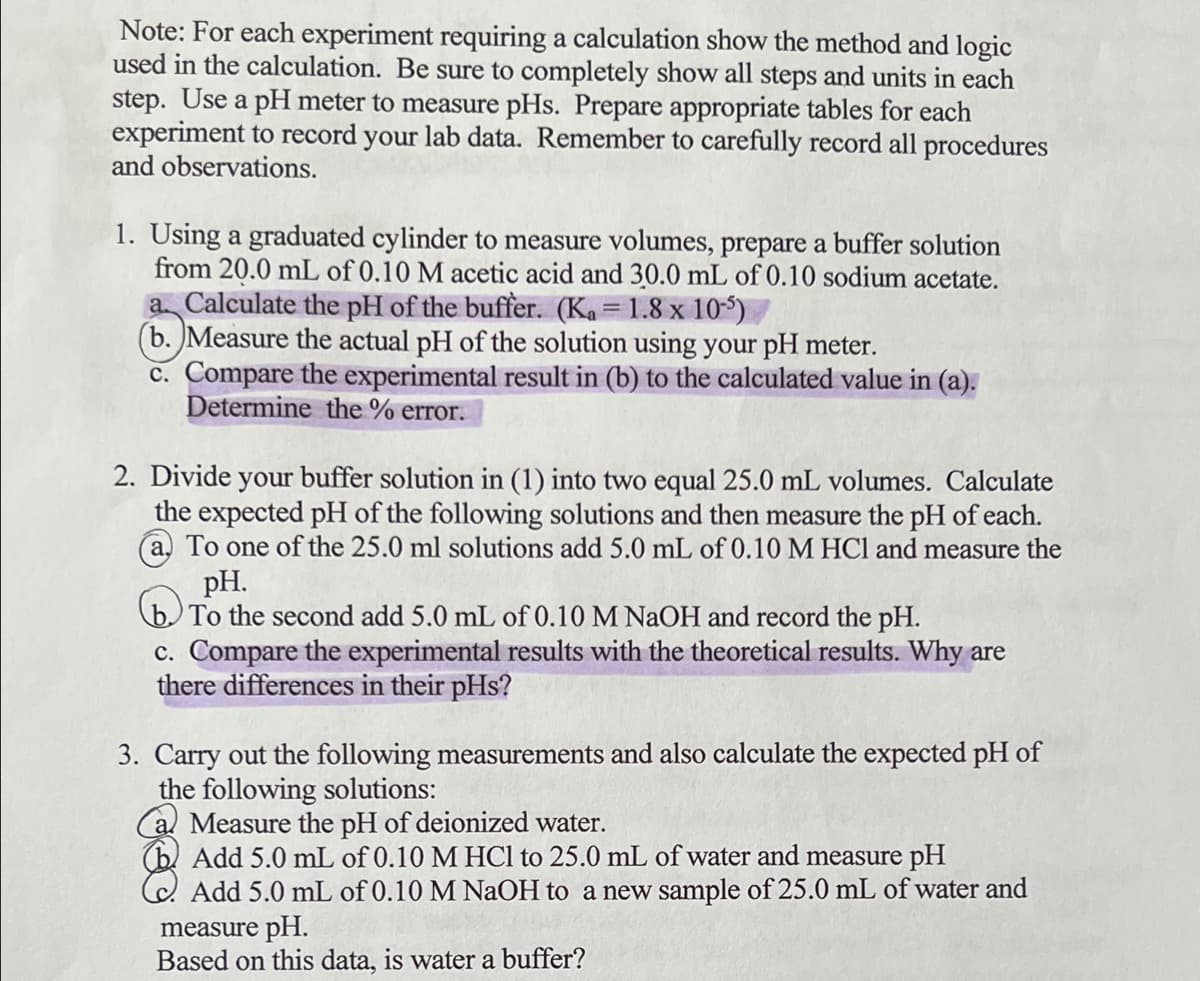1. Using a graduated cylinder to measure volumes, prepare a buffer solution from 20.0 mL of 0.10 M acetic acid and 30.0 mL of 0.10 sodium acetate. a Calculate the pH of the buffer. (Ka = 1.8 x 105) (b. Measure the actual pH of the solution using your pH meter. c. Compare the experimental result in (b) to the calculated value in (a). Determine the % error.
1. Using a graduated cylinder to measure volumes, prepare a buffer solution from 20.0 mL of 0.10 M acetic acid and 30.0 mL of 0.10 sodium acetate. a Calculate the pH of the buffer. (Ka = 1.8 x 105) (b. Measure the actual pH of the solution using your pH meter. c. Compare the experimental result in (b) to the calculated value in (a). Determine the % error.
Principles of Modern Chemistry
8th Edition
ISBN:9781305079113
Author:David W. Oxtoby, H. Pat Gillis, Laurie J. Butler
Publisher:David W. Oxtoby, H. Pat Gillis, Laurie J. Butler
Chapter15: Acid–base Equilibria
Section: Chapter Questions
Problem 99AP
Related questions
Question
I need help with 1a, 1c, 2c

Transcribed Image Text:Table I: Acetic acid/sodium acetate Buffer
Buffer
pH
pH
theoretical experimental
pH
pH
pH theoretical
pH
Error
theoretical after
experimental
Error
after adding base
experimental
Error
Initially
Initially
adding
after adding
after adding
acid
acid
base
HC2H3O2/
C2H3O2
H2O
4.95
4.516
5.14
8.62
Hand write ALL of your calculations under the table.
2. 30
1.960

Transcribed Image Text:Note: For each experiment requiring a calculation show the method and logic
used in the calculation. Be sure to completely show all steps and units in each
step. Use a pH meter to measure pHs. Prepare appropriate tables for each
experiment to record your lab data. Remember to carefully record all procedures
and observations.
1. Using a graduated cylinder to measure volumes, prepare a buffer solution
from 20.0 mL of 0.10 M acetic acid and 30.0 mL of 0.10 sodium acetate.
a Calculate the pH of the buffer. (Ka = 1.8 x 10-5)
(b. Measure the actual pH of the solution using your pH meter.
c. Compare the experimental result in (b) to the calculated value in (a).
Determine the % error.
2. Divide your buffer solution in (1) into two equal 25.0 mL volumes. Calculate
the expected pH of the following solutions and then measure the pH of each.
a. To one of the 25.0 ml solutions add 5.0 mL of 0.10 M HCl and measure the
pH.
(b To the second add 5.0 mL of 0.10 M NAOH and record the pH.
c. Compare the experimental results with the theoretical results. Why are
there differences in their pHs?
3. Carry out the following measurements and also calculate the expected pH of
the following solutions:
Measure the pH of deionized water.
(b. Add 5.0 mL of 0.10 M HCl to 25.0 mL of water and measure pH
Add 5.0 mL of 0.10 M NAOH to a new sample of 25.0 mL of water and
measure pH.
Based on this data, is water a buffer?
Expert Solution
This question has been solved!
Explore an expertly crafted, step-by-step solution for a thorough understanding of key concepts.
This is a popular solution!
Trending now
This is a popular solution!
Step by step
Solved in 3 steps with 1 images

Knowledge Booster
Learn more about
Need a deep-dive on the concept behind this application? Look no further. Learn more about this topic, chemistry and related others by exploring similar questions and additional content below.Recommended textbooks for you

Principles of Modern Chemistry
Chemistry
ISBN:
9781305079113
Author:
David W. Oxtoby, H. Pat Gillis, Laurie J. Butler
Publisher:
Cengage Learning

Chemistry
Chemistry
ISBN:
9781305957404
Author:
Steven S. Zumdahl, Susan A. Zumdahl, Donald J. DeCoste
Publisher:
Cengage Learning


Principles of Modern Chemistry
Chemistry
ISBN:
9781305079113
Author:
David W. Oxtoby, H. Pat Gillis, Laurie J. Butler
Publisher:
Cengage Learning

Chemistry
Chemistry
ISBN:
9781305957404
Author:
Steven S. Zumdahl, Susan A. Zumdahl, Donald J. DeCoste
Publisher:
Cengage Learning


Chemistry: An Atoms First Approach
Chemistry
ISBN:
9781305079243
Author:
Steven S. Zumdahl, Susan A. Zumdahl
Publisher:
Cengage Learning

Chemistry: The Molecular Science
Chemistry
ISBN:
9781285199047
Author:
John W. Moore, Conrad L. Stanitski
Publisher:
Cengage Learning

Chemical Principles in the Laboratory
Chemistry
ISBN:
9781305264434
Author:
Emil Slowinski, Wayne C. Wolsey, Robert Rossi
Publisher:
Brooks Cole